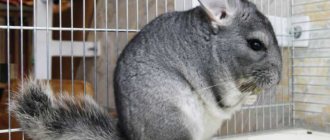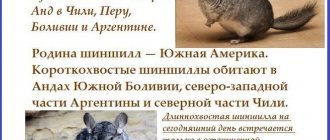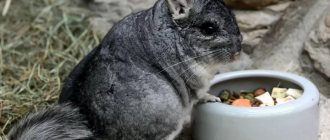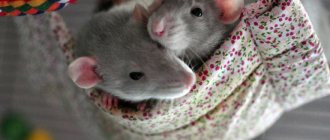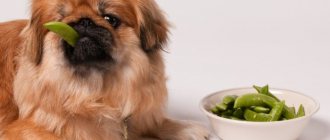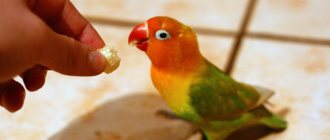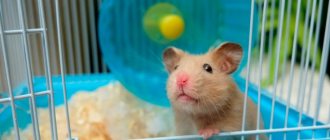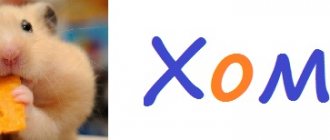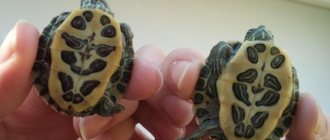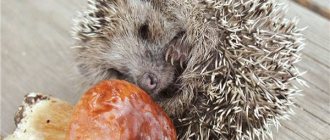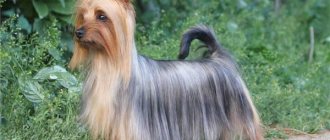Proper feeding at home is one of the main aspects of caring for a Labrador.
The development of the pet and its health depend on this, so it is necessary to approach the preparation of the diet with all responsibility.
Despite the fact that representatives of this breed are omnivores, it is necessary to take into account that there are a number of foods prohibited for them.
Feeding dry food
Choose well-known and proven brands, then you will get all the benefits of “dry” feeding - a balance of nutrients, vitamins and microelements for dogs, a minimum of time costs for you. Add wet canned food of the same brand to dry food. Don't forget about fresh water - there should be plenty of it. In summer, change it several times a day.
Feed comparison
Acana Grass-Fed Lamb
Hypoallergenic, biologically suitable for dogs (holistic), intended for sensitive animals. Contains half and half lamb and vegetables. Does not contain potatoes or grains.
Eukanuba Breed Specific Dry Dog Food Labrador Retriever
Ready food for Labradors. Its basis: poultry (chicken) and cereals. Enriched with calcium. Prevents the formation of tartar.
Advance Labrador Adult
With chicken, grains and dietary supplements for teeth, coat, heart and joints. Designed for adult dogs.
Hill's Nature's Best Canine Adult Large Breed/Giant Dry
The food is optimized for large and giant breeds. Main ingredients: corn, chicken and turkey. Suitable for Labradors as it contains glucosamine and chondroitin for joint health.
Royal Canin Labrador Retriever Adult
Food that takes into account the health problems and needs typical of Labradors: tendency to obesity, stress on joints, water-repellent properties of wool. Contains rice and other grains, poultry.
Meat
A Labrador should eat both raw and boiled meat. Fresh ones are pre-frozen, then thawed and doused with boiling water. By-products are offered to dogs only with heat treatment (cooking).
A Labrador should eat both raw and boiled meat. Fresh ones are pre-frozen, then thawed and doused with boiling water. By-products are offered to dogs only with heat treatment (cooking).
How to change the power plan
Transition your Labrador from one feeding regimen to another gradually, carefully monitoring all the dog’s reactions. The transition from natural food to dry food takes about 7 days, from dry to natural food - 2 weeks, since the pancreas needs time to fully restore its functions.
Do not mix types of food either in a bowl or at time: feed natural in the morning, dry in the evening.
The general translation scheme is as follows:
| Day | Share of natural feed, % |
| 1-7 | 30 |
| 8-10 | 50 |
| 10-14 | 70 |
| from 14 | 100 |
Natural diet
When feeding your dog natural food, you must remember: you will have to balance the nutrition in terms of nutrient content yourself, and this is not easy. Please note that it will take a lot of time and effort to prepare. Meat should be at least 50% in the diet, because dogs are carnivores. You should not feed your Labrador retriever food that is too hot or cold, stale, or improperly heat-treated (fried). Preferred Products:
- Lean meat (beef, turkey, chicken, horse meat, rabbit), offal: types that do not cause allergies, boiled, frozen or scalded, cooked offal, raw tripe, unpeeled;
- Sea fish: boneless (hake, cod, pollock), boiled to bind trimethylamine oxide, which causes anemia in animals;
- Dairy products (yogurt, yogurt, bifivit, cottage cheese, low-fat cheese), fresh milk (only for puppies up to 8 weeks old, a little at a time). Add calcium chloride to the milk feed (2 tablespoons per liter before boiling the milk);
- Porridge (rice, buckwheat), flavored with rye breadcrumbs and vegetable oils (linseed, sunflower, olive);
- Eggs (raw (with porridge) only the yolk, boiled or as an omelet - whole);
- Fruits (little by little, except grapes), vegetables (raw grated zucchini, carrots, pumpkin), herbs (dill, parsley, celery).
Sample menu for the week
| Day of the week | Menu |
| Monday | In the morning - cottage cheese with sour cream, fresh vegetables, in the evening - boiled beef, in pieces, with rice boiled in broth; |
| Tuesday | In the morning - an omelet with vegetables and cheese, raw beef, in the evening - chicken breast with buckwheat and herbs or fish; |
| Wednesday | like on Monday; |
| Thursday | like Tuesday; |
| Friday | In the morning - fresh vegetables, chopped, beef meat, raw, cut into pieces, in the evening - chicken fillet with rice; |
| Saturday | In the morning - cottage cheese with bifidok, porridge with vegetables, in the evening - beef with buckwheat and herbs; |
| Sunday | In the morning - porridge with breadcrumbs and herbs, cottage cheese. In the evening - boiled offal (raw tripe) with buckwheat. |
Menu for the week
| Day of the week | Daily ration |
| Monday | 300 g boiled beef, 200 g rice, 100 g boiled carrots, 150 g cottage cheese, 50 g parsley |
| Tuesday | 300 g chicken meat, 200 g buckwheat, 150 g baked pumpkin, 100 g curdled milk, chicken yolk |
| Wednesday | Boiled fish – 300 g, rice porridge – 250 g, raw zucchini and fermented baked milk – 100 g each and 25 g of greens |
| Thursday | 300 g raw tripe, 200 g buckwheat porridge, 150 g fruits and vegetables, 150 g cottage cheese |
| Friday | 300 g turkey, 200 g buckwheat porridge, 100 g boiled pumpkin and zucchini, 150 g cheese, 25 g lettuce |
| Saturday | 300 g offal, 200 g rice porridge, 200 g carrots and beets, 100 g curdled milk |
| Sunday | 300 g fish, 150 g yogurt, 200 g rice porridge, 100 g omelette, 50 g raw pumpkin |
What to feed a Labrador puppy
Your puppy will be stressed when moving to you. Don’t put him through the trouble of indigestion, find out from the breeder what kind of food he’s used to, and feed him the same thing, at least for the first time.
| Age, months | What to feed |
| up to 1 | breast milk |
| 1-2 | breast milk + complementary foods (dry food soaked in yogurt or kefir (not chicken-based), semi-liquid buckwheat, rice porridge; vegetables (except potatoes), cottage cheese, fish - all in puree form) |
| 3-4 | gradually wean off from “mother”, increase the share of ordinary soft food, replace cottage cheese with meat, poultry and fish cut into small pieces |
| 5-6 | accustom to solid foods rich in protein, vitamins and minerals (meat, sea fish, dairy products, fish oil, powdered eggshells, raw vegetables) |
| 6-10 | regular puppy diet (natural feeding or dry food “for large breed puppies” or “for Labrador Retriever puppies”) |
| 10-12 | transfer to an “adult” diet |
Teach your puppy:
- eat a single serving completely and immediately (keep the bowl of food available for no longer than 15 minutes, give the supplement a little at a time, only for puppies up to six months old),
- do not “beg” the host’s food (do not offer food from your table and forbid children to do this),
- leave the kitchen immediately after finishing the meal.
Look at the discipline these Labrador puppies have!
How to feed a Labrador puppy correctly
Observe the following rules from a very early age of the puppy:
- Feed and water from a high stand (bowls are fixed at the height of the animal’s elbows so that the dog’s posture does not deteriorate).
- Give slightly warmed food (30-37 degrees).
- Provide the puppy with peace afterward, do not take him for a walk to avoid stomach volvulus.
- Do not give food between feedings.
- Introduce new products gradually, starting with small quantities.
- In the first half of the day, feed lightly (dairy products), in the second - give the main part of the food (meat, eggs, vegetables, cereals) and vitamins, since in the afternoon and at night the secretion of gastric juice increases in Labradors.
- Follow a diet appropriate for the puppy's age.
| Puppy age, months | Frequency of feedings, once a day | Single (daily) portion, g |
| 1-2 | 6 | 50 (300) |
| 2-4 | 5 | 60-80 (300-400) |
| 4-6 | 4 | 100 (400) |
| 7-12 | 3 | ~130 (400) |
| from 12 | 2 | 250 (500) ± 70-100 |
Dry food is dosed in accordance with the manufacturer's instructions.
The greatest need for nutrients and biologically active substances occurs in young Labradors at 2-6 months; Pay special attention to your puppy's diet at this age.
From 4 months, feed supplements with calcium, glucosamine and chondroitin for the proper formation of bones and joints, prevention of rickets, hip dysplasia.
You can also watch a short video with an example menu for a Labrador puppy.
Utensils for food
All dishes for the dog should have smooth edges so as not to cut the tongue. Buy stainless steel bowls. Mount them on a bracket that you can purchase at a pet store. This tripod allows you to raise the bowl to the level of the dog’s elbow joints. This allows your Labrador to develop good posture.
15 minutes after eating, remove the bowl and wash it. This will teach the dog to routine and discipline.
What to feed an adult Labrador
A dog’s diet affects its condition, coat condition, activity, and the presence of food allergies (diarrhea, vomiting, rashes, scratching, “running” ears).
Weigh your Labrador and calculate the daily amount he needs:
- meat and meat products - 10-20 g/kg weight (3-4 g/kg protein),
- fat 1-2 g/kg (1/6 of meat),
- carbohydrates - 5-6 g/kg (1/2 of meat).
Divide this amount into two meals: morning and evening. If the dog is inactive, it should be fed once a day.
With dry food it is easier to monitor the dog’s weight, the completeness of the diet, and control the manifestations of allergies than when feeding natural products.
What to feed an old dog
Age-related changes in the functioning of the Labrador's body are partially compensated by nutrition. It is corrected like this:
- add vitamins to slow down the withering process,
- reduce portions or calorie content of food (by 20%),
- enrich the diet with calcium for teeth and claws,
- add products with glucosamine (beef, hard cheese, cartilage, skin and tendons, salmon) to prevent arthritis,
- follow general nutritional rules, since older dogs often suffer from indigestion.
Feeding pregnant and lactating bitches
Pupping in Labrador bitches lasts about 2 months.
For the first half of the pregnancy, feed the pregnant dog unchanged (excess weight will complicate childbirth).
In the second , they increase the amount of meat (up to 1.5 kilograms per day or ~ 10-15% per week), vitamins and microelements (strictly observing the proportions) or simply switch to food for puppy bitches, the composition of which already takes into account the physiological state and needs animal in building material.
If the dog gets what it needs, then whelping and subsequent lactation will have little or no effect on its condition, coat quality and overall health.
If you switch the bitch to puppy food, there is no need to increase the portions or add vitamins and microelements. Feed your dog 6-8 hours after giving birth unless he asks sooner. With milk, a dog gives away 4-7% of its body weight every day. To ensure that the puppies grow up healthy and do not “drink” it, feed the bitch more often than usual (3-5 times) - the same as in the second half of pregnancy.
Remember about fresh water: it is needed for milk production. If the dog's diet is natural, its food should be liquid (thin porridge, meat soup, milk). Do not give potatoes: starch can clog the milk ducts.
A month to a month and a half after giving birth, gradually reduce the number of times the bitch feeds and the amount of water she drinks in order to smoothly complete the lactation period.
Daily norm
Strict requirements are imposed on Labrador cubs. Breeders also take care of feeding the one-month-old puppy.
The main element on which they rely when creating a diet for puppies of 2 months is protein. It is a building block and an essential substance for the body. Labrador is a fast-growing breed, so the dog needs high-calorie food.
For puppies
The main element on which they rely when creating a diet for puppies of 2 months is protein. It is a building block and an essential substance for the body. Labrador is a fast-growing breed, so the dog needs high-calorie food.
The main element on which they rely when creating a diet for puppies of 2 months is protein. It is a building block and an essential substance for the body. Labrador is a fast-growing breed, so the dog needs high-calorie food.
To meet the nutritional needs of a Labrador puppy, you need:
For Labrador it is preferable to cook porridge in broths; additionally add fresh fruit, 5 grams per 1 kg daily.
For Labrador it is preferable to cook porridge in broths; additionally add fresh fruit, 5 grams per 1 kg daily.
As the animal grows older, its activity decreases, the dog’s growth process stops, and its calorie requirement decreases. The norm and strict adherence are the key to the health of the Labrador. The owner must adhere to the recommendations for feeding natural food.
For Labrador it is preferable to cook porridge in broths; additionally add fresh fruit, 5 grams per 1 kg daily.
What to feed to avoid allergies
There are many allergy sufferers among the labs. Switch your labrador on dry food to a hypoallergenic line. Consistently exclude milk, chicken, beef, soy and wheat from the natural diet, as the animal can react to any of these products. It takes a long time (a month and a half or more), but as a result you will learn how to feed your special dog.
Follow a hypoallergenic diet; it will be prescribed to your pet by a veterinarian. Using a blood test and intradermal tests, he will determine the type of allergen.
What food to give to a Labrador with health problems
Obesity
Correct your Labrador's excess weight: reduce the portions by half or switch to food for low-active dogs, which is low in protein and fat, but high in levocarnitine and fiber.
Infectious and oncological pathologies, severe fever
Accompanied by exhaustion of the dog - cachexia. Such animals need a high-energy diet containing a lot of proteins and fats, glutamine, arginine, trace elements, vitamins and fatty acids, but few carbohydrates.
Joint dysplasia
A sick Labrador should receive low-calorie food, with less fat, phosphorus and calcium, and more levocarnitine: weight gain slows down, the load on the bones decreases.
Mineral supplements
The decision on the need for mineral supplements is made together with the veterinarian after assessing the dog’s condition. Labrador retrievers that have problems with skin, fur, teeth, as well as puppies and pregnant bitches require additional saturation with useful substances.
Adherents of a natural diet or budget options for dry food should feed the animal.
Labradors eat with pleasure, so the dog’s refusal of his favorite foods should alert the owner.
Labradors eat with pleasure, so the dog’s refusal of his favorite foods should alert the owner.
What not to feed
There are foods that dogs of any age and physiological condition should not be fed. Do not give them to your pets under any circumstances.
- Refined sugar: will lead your Labrador to obesity and unbalanced diet. Chocolate is dangerous: the more cocoa it contains (dark varieties), the more caffeine and theobromine, the more likely convulsions, tremors, arrhythmia, and increased thirst are.
- Fat: heavy fatty food will “give” your Labrador problems with the liver and inflammation of the pancreas.
- Salty, smoked, spicy, spices: the first and second will cause severe thirst and, as a result, expansion of the stomach and intestinal volvulus; the third and fourth will ruin the dog’s sense of smell.
- Bones: fish - will get stuck in the throat, cause inflammation, and it will be difficult for the dog to breathe; tubular - sharp fragments will injure the oral cavity, esophagus, stomach and intestines; raw ones are a source of parasites.
- Potatoes, pasta: labs do not digest starch well, and gluten in wheat flour is the cause of allergies.
What not to do
If you want your pet to live longer, you need to know which foods to avoid.
List of foods that should not be given:
- Fatty foods, including fatty meat products.
- Bones. They have no nutritional value. Harmful to teeth, causing constipation, intestinal volvulus and perforation of their walls. Chicken and tubular ones are especially harmful: when chewed, they split into sharp pieces.
- Legumes, pearl barley, semolina and oatmeal. Causes indigestion.
- Potatoes, cabbage. Causes bloating.
- Smoked meats, sausages, frankfurters. They destroy the liver of dogs, leading to the death of young animals.
- Sweets and chocolate. They cause tearing, destroy tooth enamel, disrupt the functioning of the digestive tract and salivary glands, and impair appetite.
- Pickles, marinades, herbs, spices. They impair the sense of smell and harm taste buds. Harmful to the stomach, causing heartburn.
- Milk. Causes diarrhea.
- Bread and other baked goods. Not digestible, contributes to obesity.
- Citrus fruits, avocados, grapes. Broccoli.
